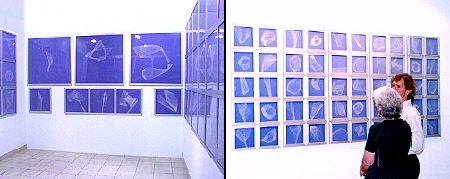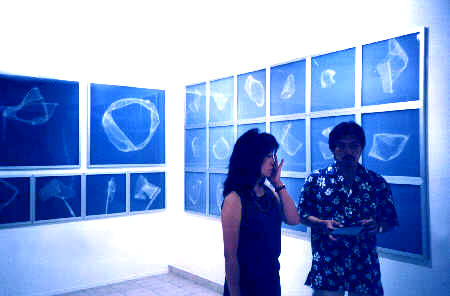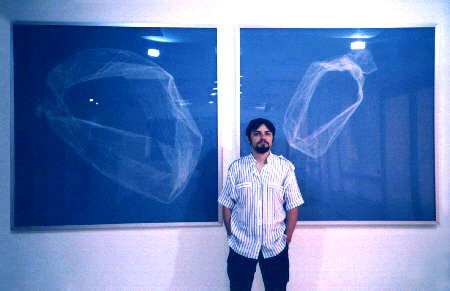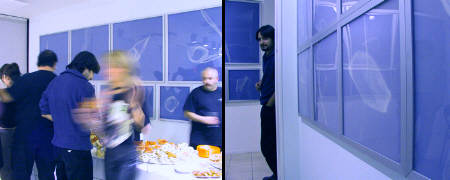Epoché
una cena in studio con Roberto
Cresti e Alessandro Sibilia
Roberto
Cresti - mi verrebbe da parlare di
una forma di poesia lirica. Sembra che si
alterino certi principi di simmetria
presenti in lavori precedenti, con
allungamenti in bozzoli, crisalidi dalle
forme più improbabili ed effimere, quindi
anche una registrazione di eventi sottili,
attraverso dissolvenze e addensamenti a
partire dal vuoto, da un’idea di spazio
aperto, fluttuante. A lavorarci di pure
analogie potresti pensare anche ad un
mondo marino, a meduse, figure che
assumono una valenza anche in relazione
allo spazio che hanno intorno. C’è una
sovversione degli aspetti di alto e di
basso, si perdono i punti di orientamento,
e nelle immagini più allungate vi è forte
il senso della forma instabile, della
perdita del centro, con un valore
ipnotico. Io direi una libertà di
incominciare da idee più che non da forme,
con tutto quello che ne può venire in
termini di eventualità e di libertà di
espressione. Mi vengono in mente dei versi
di Ungaretti: “Non ho voglia / di tuffarmi
/ in un gomitolo / di strade... sto / con
le quattro / capriole / di fumo / del
focolare”. Penso all’idea delle volute di
fumo di un focolare che si spegne.
Alessandro
Sibilia - si, le volute di fumo sia
come tema tradizionale che come nuove
forme della rappresentazione. La
distinzione tra mondo delle forme e delle
idee, quindi non più forme di
rappresentazione del reale quanto
piuttosto l’espressione di un carattere
interiore, di uno stato d’animo, di
momenti passeggeri ed emozioni. Sono
immagini che non danno riferimenti, ma
sono impaginate e strutturate in maniera
esatta e definita. Alla fine è come se
fosse proposto un sistema di nuove
coordinate spazio-temporali. Certo da
questo spunto si può sottolineare il
passaggio verso un coinvolgimento dello
spazio; quasi come se i lavori si
alleggerissero al punto da staccarsi dalle
pareti per affrontare la terza dimensione,
il coinvolgimento dell’ambiente e lo
spazio dello spettatore.
Roberto
Cresti - tu come ci sei arrivato?
Matteo
Soltanto - l’osservazione della
realtà mi ha spinto ad andare oltre il suo
ingrandimento, su - o giù - fino alla
scarnificazione dell’oggetto, della forma
osservata, raggiungendo di questo passo le
sue informazioni chimiche, il suo DNA,
arrotolato, ventoso, sfuggevole e mutante,
ed è proprio la mutazione che cerco di
individuare, il momento che sta passando
ed il risultato del suo passaggio. Mi
capita di avvicinare i lavori, come
fossero fotogrammi in serie di una stessa
azione, di uno stesso processo,
stravolgendone poi l’ordine e facendo
assumere alla sequenza un carattere
diverso, e di qui, ipoteticamente,
all’infinito. Ho la sensazione che queste
sospensioni si muovano come in una
successione di eventi che si manifestano
prescindendo da tutto e da tutti, quasi
autonomamente, in silenzio, con lentezza.
Il mio sguardo si è forse imbattuto nelle
strutture originarie, in un "fumo fluido",
primordiale, dando vita ad una immagine
che sembra appartenermi profondamente ma
anche essermi contemporaneamente antenata
e postera.
Roberto
Cresti - forse allora si potrebbe
sottolineare un altro dato, facendo
riferimento al metodo della Fenomenologia
di Husserl, che è la messa tra parentesi,
la sospensione fenomenologica, l’epoché,
letteralmente la sospensione del giudizio:
ho il mondo davanti, in qualsiasi forma,
ma non lo acquisisco categorialmente,
attraverso una logica rappresentativa, che
inquadra, dimensiona. L’oggetto, l’idea,
un valore è in un certo qualmodo lasciato
libero. Detta come la diceva Husserl, “la
sospendo tra essere e non essere”, cioè
l’acquisisco come quel fenomeno puro che
non cade né nella contiguità dello spazio
né nella successione del tempo. Lascio
ogni cosa libera di determinarsi di fronte
ai sensi senza un senso preliminare,
quindi mi dispongo di fronte a tutto
quello che avviene con il massimo di
possibilità e di libertà, per cui le cose
comunicano con la mia percezione in modo
diretto e pertanto non già determinato da
un senso. Quindi la “sospensione del
giudizio” è anche il tentativo di non
interferire in maniera troppo forte nei
confronti del fenomeno e di lasciarlo
libero di stupirmi e manifestarsi come
qualcosa che ha una sua vita ed un suo
destino che prescinde completamente da me.
La libertà di determinare una forma senza
inquadrarla secondo coordinate oggettive.
Del resto è la pura oggettività, nel
momento in cui una cosa non la conosco.
|
|
Epoché
a supper in the studio with
Roberto Cresti and Alessandro Sibilia
Roberto
Cresti - Perhaps I might even
mention a form of lyrical poetry. And it
seems to me that certain principles of
symmetry present in previous works have
altered into pod like lengthenings,
chrysalises of improbable and ephemeral
shapes, and therefore also a recording of
subtle events. Here one is dealing with
the question of the fading of densities
arising from emptiness, from an idea of
open space, something fluctuating. Delving
into the matter by analogy, I might
suggest something from the marine world,
the jelly fish, creatures whose
configuration is determined by surrounding
space. However here one does detect a
subversion of the ideas of high and low,
the orientation points are acceptable and
in the elongated images there is an
overriding sense of unstable form, a loss
of centre, a hypnotic alteration between
fading and gathering. I would say the
liberty of starting out from ideas rather
than forms, with everything that can
follow in terms of chance creation and
free expression. Some verses by Ungaretti
spring to mind: “Non ho voglia / di
tuffarmi / in un gomitolo / di strade…sto
/ con le quattro / capriole / di fumo /
del focolare” “I don’t feel / like diving
/ into a ball / of streets… I remain /
with the four / cartwheels / of smoke / in
the fireplace”, which encapsulate the idea
of extinguishing smoke swirls in a
fireplace.
Alessandro
Sibilia - yes, the smoke spirals
either as a traditional theme or as new
forms of representation. The distinction
between the world of forms and ideas,
therefore we’re no longer talking about
forms of representation of reality as much
as we are about the expression of an
interior quality, of a state of being, of
fleeting moments, and human emotions.
These are images that offer no explicit
references, yet their layout and structure
is exact and definite. Ultimately it is as
though one is witnessing the proposal of a
new system of space time coordinates.
Certainly from this stating point one
could even enphasise the transition
towards an incursion into space, almost as
if the progressive lightening of these
forms gradually led to their separation
from the wall, and thus to an adjustment
to the third dimension of the surrounding
environment and the spatial dimension of
the spectator.
Roberto
Cresti: How did you get there?
Matteo
Soltanto - My observation of reality
pushed me to go beyond mere enlargement,
up or down, towards the stripping down of
the object or form, reaching with this
step the chemical data, if you like, its
DNA, entwined, windy, fleeting and
mutable, and I am currently trying to
identify the instances of change,
transition in the present moment, and the
results of transition. Often when I finish
works of similar design, I then put them
along side one another as if they were the
consecutive photograms of a single action,
of a single process, in other words. At
times the series can be distorted in an
experimental way, allowing the succeeding
pieces to assume a different character,
and from this point onwards, endlessly so,
at least hypothetically. I feel that these
suspensions float ahead like a series of
events, an evolution which, almost
entirely removed from everyone and
everything else, is slowly and silently
revealing itself. And thus my gaze has
fallen upon certain primary structures,
found in primordial “smoke fluid”, giving
life to an image that seems to be not only
a part of my personal make up, but also
something that has preceded me, something
that will also out live me.
Roberto
Cresti - Perhaps another fact might
also be emphasised, by referring to the
phenomenological method of Husserl, that
is an opening of a parenthesis, the
phenomenological suspension, “l’epoche'”,
literally the suspension of judgement: I
have the world before me, in whatever
form, but I do not apprehend it
categorically through representative logic
which arranges and measures. The object,
the idea, a value left in some way
“undisturbed”. Said as Husserl said it, “I
suspend it between being and non being.”
In other words I apprehend it as that pure
phenomenon which falls neither in the
contiguity of space nor in the succession
of time: I leave every thing free to
establish itself before the senses without
any preliminary understanding, therefore I
place myself before everything that
happens with the utmost of opportunity and
freedom, through which things communicate
directly with my perception and not
however determined by a meaning. Therefore
the suspension of judgement is also the
attempt of not interfering too heavily
with a phenomenon, allowing it the freedom
to amaze me and reveal itself as something
that has its own life and destiny entirely
irrespective of my own. The freedom to
determine a form without isolating it
according to objective coordinates. After
all pure objectivity arises in the moment
in which I encounter something for the
first time.
|


 .
.



